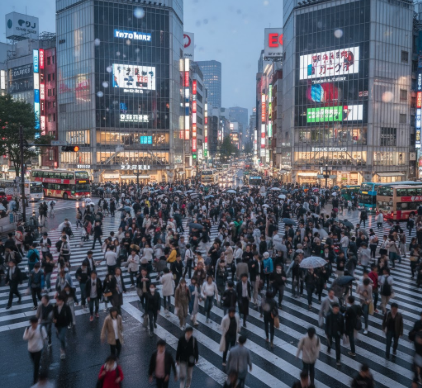Imagine standing on a street corner where the entire world seems to converge at once. A symphony of neon lights paints the sky, giant video screens broadcast a constant stream of vibrant advertisements, and the low hum of a thousand conversations blends with the distant rumble of trains. This isn’t a scene from a futuristic movie; this is the everyday reality of Tokyo’s Shibuya Crossing. It’s more than just an intersection; it’s the living, breathing heart of a metropolis, a place where order and chaos perform a mesmerizing daily ballet that leaves visitors utterly spellbound.
The real magic happens when the traffic lights turn red. All vehicular traffic in every direction comes to a complete, silent halt. For a fleeting moment, there’s a deceptive stillness, a collective intake of breath. Then, the pedestrian signals flash green, and the floodgates open. From every corner, a wave of humanity surges into the vast intersection. People cross diagonally, straight ahead, and in every conceivable direction, forming a torrent of purposeful movement. It’s a phenomenon famously known as the
“Shibuya Scramble,” and it’s a breathtaking display of collective, unspoken coordination. You’d expect collisions, confusion, and frustration, but instead, you witness a fluid, efficient dance as thousands of people navigate the shared space with a practiced, almost unconscious ease.
At its peak, it is estimated that over 2,500 people cross the Shibuya intersection during a single green light signal, which typically lasts about two minutes. This can amount to nearly half a million people crossing in a single day. The sheer volume of pedestrians makes it one of the most densely packed crossings in the entire world, a true testament to Tokyo’s incredible urban scale.
A Microcosm of Modern Japan
Why does this particular crossing captivate so many people from around the globe? Because it perfectly encapsulates the essence of modern Tokyo. It is a powerful symbol of
immense energy, relentless forward motion, and technological saturation. The towering buildings that frame the intersection are not merely concrete and steel; they are canvases adorned with massive LED screens that never sleep, broadcasting everything from the latest J-pop music videos to high-fashion commercials in a silent, colorful loop. This constant visual stimulation, combined with the sheer density of people, creates an atmosphere that is uniquely exhilarating and almost overwhelming. It represents a society that is hyper-connected, fast-paced, and incredibly efficient, where thousands of individuals can share a small space without generating friction, moving together as one organism.
Finding the Perfect Vantage Point
Experiencing the scramble from within the moving crowd is one thing, but to truly appreciate its magnificent scale, you need to see it from above. For many years, the go-to spot for an iconic view was the Starbucks located in the Tsutaya building, which overlooks the intersection. It offers a fantastic, eye-level perspective through its large glass windows, allowing you to feel the energy without being swept away by it. It remains an incredibly popular choice, though securing a window seat often requires a great deal of patience and a bit of luck. For a more breathtaking, panoramic perspective, the Shibuya Sky observatory, perched atop the Shibuya Scramble Square building, is an unmatched experience. From its open-air deck, hundreds of meters in the air, you can watch the waves of people look like tiny, purposeful ants, with the sprawling, endless Tokyo skyline serving as a jaw-dropping backdrop. Many other buildings surrounding the crossing also have cafes and restaurants on their higher floors that provide excellent, and often less crowded, viewing opportunities for those willing to explore.
More Than Just a Crossing Point
Shibuya Crossing is not merely a transit point for commuters and shoppers; it’s a profound cultural landmark and a central meeting place for an entire generation. Just a few steps from the crossing, right outside Shibuya Station, stands the famous and much-loved statue of
Hachiko, the loyal Akita dog who waited for his deceased owner at the station every single day for nine long years. This simple bronze statue has become one of Tokyo’s most iconic and beloved meeting spots, a point of stillness and sentimentality amidst the constant, dizzying flow of the crowd. It’s a reminder of loyalty and connection in a place defined by fleeting encounters.
The crossing itself transforms into a massive open-air venue for public gatherings and celebrations. On Halloween, it becomes an impromptu, unofficial costume parade where thousands of people show off their creative outfits. On New Year’s Eve, tens of thousands gather for the final countdown, turning the entire area into a massive, joyous street party. It has also been immortalized in popular culture, serving as a dramatic and instantly recognizable backdrop in films like
Lost in Translation and
The Fast and the Furious: Tokyo Drift. Its visual power makes it a cinematic shorthand for “Tokyo” in the global imagination. It’s a stage where the daily drama of life unfolds, a place where countless personal stories intersect for a fleeting moment before diverging once more into the city’s vast network of streets.
The Unstoppable Rhythm of the City
The true wonder of Shibuya Crossing is its unwavering, predictable rhythm. Every few minutes, the cycle repeats itself with the precision of a well-oiled machine: the stop of traffic, the surge of people, the retreat to the sidewalks, and the return of cars. It’s a reliable, perpetual pulse that mirrors the city’s own heartbeat. Standing there, whether on the sidewalk or watching from above, you feel connected to something much larger than yourself—a massive, living organism of a city that is always awake, always evolving, and always moving forward. It’s an experience that can be overwhelming, yet strangely calming. In the perfectly organized chaos of Shibuya, you don’t just see Tokyo; you feel its endless, vibrant, and utterly infectious energy.









